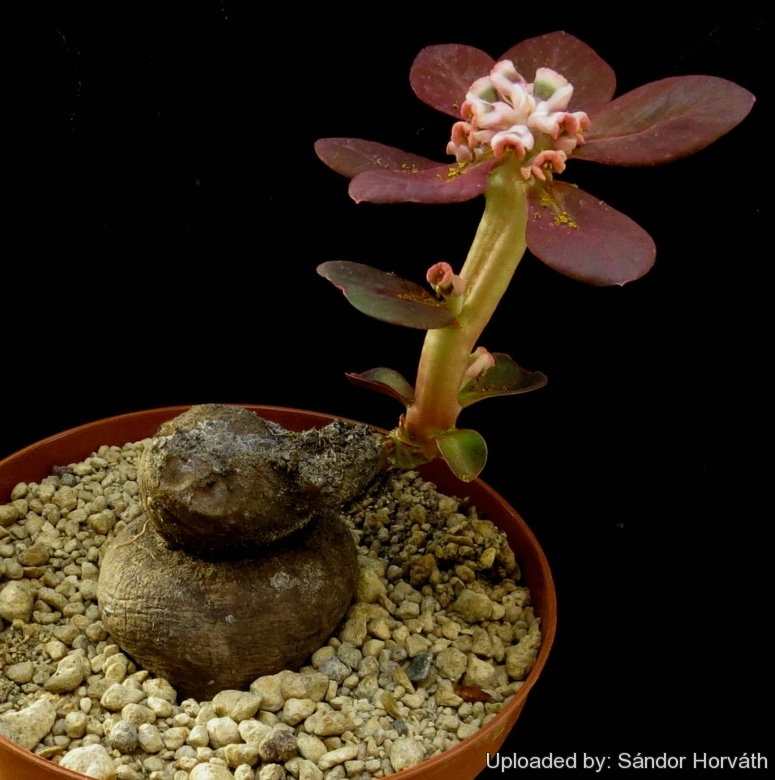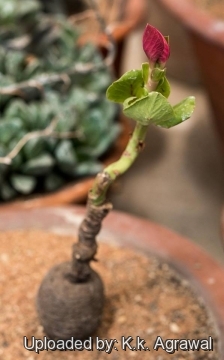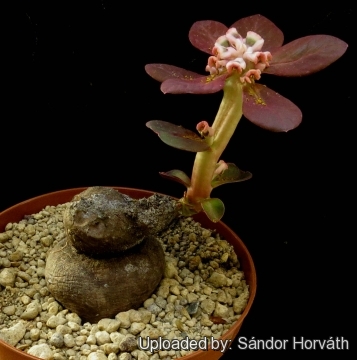




Your support is critical to our success.
- Encyclopedia of SUCCULENTS
- Encyclopedia Index
- Families
- Genera
- Species
- Euphorbiaceae
- Euphorbia
- Caudiciforms
Since 4 Aug 2013

Origin and Habitat: Tanzania
Habitat and ecology: Euphorbia bisglobosaSN|29178]]SN|29178]] grows among flat rocks with gritty black soil.
Altitude range: 1950-2500 metres above sea level.
Synonyms:
- Euphorbia bisglobosa Bruyns
- Monadenium globosum P.R.O.Bally & S.Carter
JAPANESE (日本語): 赤い花みたい, グロボースム
Description: Euphorbia bisglobosaSN|29178]]SN|29178]], much better known under its old name Monadenium globosumSN|29537]]SN|29179]], is a geophyte perennial herb, with a tuberous root about 4-6 cm in diameter producing 1-2 woody subterranean stems 2 cm long and with fleshy upright annual stems topped with a leaf crown. The flowers are white to greenish-pink to bright red.
Rootstock: Tuberous irregularly ovoid and more or less woody 4-6(-7) cm in diameter.
Stems: Subterranean stems one or two, perennial, stocky, woody and very short (1-2 cm long). Annual aerial stems, upright unbranched 8(-20) cm tall herbaceous and succulents.
Leaves: Subsessile, rosulate, crowded at the tip of the annual stems, obovate, to 6 cm long and 3 cm wide, apex rounded, hairless, green tinged with red, often almost entirely red on the back.
Flowers (cyathia): Congested into a globose head of 1-forked cymes about 3 cm in diameter with peduncles 4-8 mm long. Bracts pink to bright red, free, similar in size to the involucre, cyathium approximately 4x4mm, and nectar glands in an open ring, pink, ca. 2 mm acrross.
Fruit (capsules): Tri-lobed about 3.5 mm in length and diameter, obtuse, lobes continuing into small hills. Pedicel fleshy up to 4 mm long.
Seeds: Oblong 2mm long and 1.3 mm wide, finely tuberculate and carunculate.
Similar species: The closest relative are Monadenium pedunculatumSN|29545]]SN|29542]], Monadenium pseudoracemosumSN|29542]]SN|29545]], Monadenium capitatumSN|29179]]SN|29537]].
Bibliography: Major references and further lectures
1) Susan Carter, A. R. Smith “Flora of Tropical East Africa” Euphorbiaceae (part 2 1988) CRC Press, 01/Jun/1988
2) “Monadenium globosum P.R.O. Bally & S. Carter” in: African Plants Database (version 3.4.0). Conservatoire et Jardin botaniques de la Ville de Genève and South African National Biodiversity Institute, Pretoria, "Retrieved [set month and year]", from <http://www.ville-ge.ch/musinfo/bd/cjb/africa/>.
3) Philippe Corman “Monadenium globosum” Fiche créée le 27/07/2008. Encyclopédie des Cactus, Plantes Grasses et Succulentes <http://www.cactuspro.com/encyclo> Web. 25 Oct. 2014.

Euphorbia bisglobosa Photo by: K.k. Agrawal

Euphorbia bisglobosa Photo by: Sándor Horváth
Cultivation and Propagation: Euphorbia bisglobosaSN|29178]]SN|29178]] (Monadenium globosumSN|29179]]SN|29179]]) is an interesting addition to a collection, but rarely seen in cultivation. It can be grown outdoors in frost-free climates and forms a small shrub.
Growth rate: It grows well, though very slowly, but it possible to increase the speed of growth to some extent by providing adequate amount of water, warmth, and fertilizer during the active growing season, but it’s susceptible to rotting if too wet.
Exposure: It needs light shade, but the caudex should be in the shade, while the leaves prefer some sun. Avoid direct blasting sun in summer. Bright light if grown indoors.
Soil: In pots it needs a very porous potting medium (add pumice, vulcanite, and perlite). It does better in a rather acidic soil.
Waterings: Water frequently while plant is in full growth, but keep dry during the winter after the branches have died back. It rot easily and do NOT like a lot of water when it has no leaves.
Fertilizer: Benefits from moderate doses of a well-balanced, slow-release fertilizer.
Frost tolerance: Due to its African origin keep warm in winter, the minimum safe average temperature is 15°C, although it can go lower for short periods. It can be grown outdoors in frost-free climates, need anyway to kept above 10°C and dry in winter. It is very prone to rot in cool, wet conditions. USDA Zone 10-12, but does very well in containers.
Manteinance: Repot every two years. It like pots with generous drain holes. In the winter, the branches die back and should be cut back to encourage rebranching, to maintain an attractive shape and to ensure caudex habit.
Pest and diseases: White meldew, mould and other fungi.
Propagation: The species can be propagated by both seeds and cuttings. The plants for seed production are generally grown from cuttings since these bloom more freely. The plants for decoration are grown from seed since they develop a caudex.
| Your Actions | |
|---|---|
| Back to Euphorbia index | |
| Back to Euphorbiaceae index | |
 |
Back to Succulents Encyclopedia index |
Privacy stantement - Terms and conditions - How to cite - About us - Feedback - Donate



